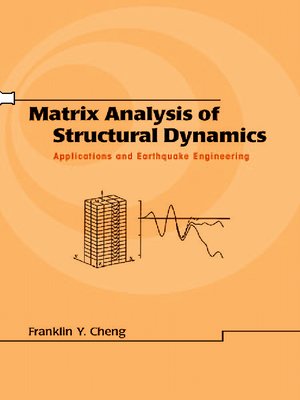Matrix Analysis of Structural Dynamics
ebook ∣ Applications and Earthquake Engineering · Civil and Environmental Engineering Series, Book 4
By Franklin Y. Cheng

Sign up to save your library
With an OverDrive account, you can save your favorite libraries for at-a-glance information about availability. Find out more about OverDrive accounts.
Find this title in Libby, the library reading app by OverDrive.



Search for a digital library with this title
Title found at these libraries:
| Library Name | Distance |
|---|---|
| Loading... |
Functions as a self-study guide and textbook containing over 110 examples and 165 problem sets with answers, a comprehensive solutions manual, and computer programs that clarify arithmetic concepts-ideal for a two-semester course in structural dynamics, analysis and design of seismic structures, matrix methods of structural analysis, numerical methods in structural engineering, and advanced structural mechanics and design!
This book uses state-of-the-art computer technology to formulate displacement method with matrix algebra, facilitating analysis of structural dynamics and applications to earthquake engineering and UBC and IBC seismic building codes.
Links code provisions to analytical derivations and compares individual specifications across codes, including the IBC-2000!
With 3700 equations and 660 drawings and tables, Matrix Analysis of Structural Dynamics: Applications and Earthquake Engineering
- examines vibration of trusses, rigid and elastic frames, plane grid systems, and 3-D building systems with slabs, walls, bracings, beam-columns, and rigid zones
- presents single and multiple degree-of-freedom systems and various response behaviors for different types of time-dependent excitations
- outlines determinant, iteration, Jacobian, Choleski decomposition, and Sturm sequence eigensolution methods
- details proportional and nonproportional damping, steady-state vibration for undamped harmonic excitation, and transient vibration for general forcing function
- includes P-
 effects, elastic media, coupling vibrations, Timoshenko theory, and geometric and material nonlinearity
effects, elastic media, coupling vibrations, Timoshenko theory, and geometric and material nonlinearity
- illustrates free and forced vibrations of frameworks and plates stressing isoparametric finite element formulation
- offers several numerical integration methods with solution criteria for error and stability behavior
- details models and computer calculations for bracings, RC beams and columns, coupling bending, and shear of low-rise walls
- and more!







